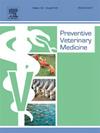Evaluation of antibiotic purchase data for ceftiofur and enrofloxacin and minimum inhibitory concentrations among Escherichia coli isolates from swine farms in the Midwestern United States using multiple statistical models
IF 2.2
2区 农林科学
Q1 VETERINARY SCIENCES
引用次数: 0
Abstract
Antimicrobial resistance is considered a global One Health threat. Controlling selection pressure by reducing antibiotic use in livestock is a significant component of the response to this threat. The science concerning use and resistance is complicated and affected by time from antibiotic exposure, changing bacterial fitness, and varies by drug and pathogen. From May 2020 through October 2023, we collected intestinal (substandard and sick pigs) and fecal swab (healthy pig) samples at breed-to-wean (BTW) and wean-to-market (WTM) swine production sites and isolated E. coli bacteria. Antibiotic susceptibility testing was performed on these isolates to determine minimum inhibitory concentrations (MIC) for ceftiofur and enrofloxacin. Monthly antibiotic purchase data were used to calculate the active milligrams of drug purchased and these were divided by the kilograms of pigs produced from a farm site to provide a mass-adjusted proxy metric for farm-level antibiotic use. The relationship between use and MIC was then evaluated using a variety of multivariable statistical models. Across multiple modeling approaches, both farm type (i.e., BTW versus WTM) and farm-level antibiotic use maintained statistically significant relationships relative to E. coli MIC values for each respective drug. Use of ceftiofur and enrofloxacin can lead to increased MIC values among E. coli over time. The reasons for antibiotic purchases were not tracked as part of this project. Future work should evaluate the age of the individual pig and the time from last treatment when sampling these animals to separate out the group from individual-level effects of antibiotic use.
使用多重统计模型评估美国中西部养猪场头孢替福和恩诺沙星抗生素采购数据和大肠杆菌分离株的最低抑菌浓度。
抗菌素耐药性被认为是一个全球性的“同一个健康”威胁。通过减少牲畜抗生素的使用来控制选择压力是应对这一威胁的一个重要组成部分。有关抗生素使用和耐药性的科学是复杂的,受抗生素暴露时间的影响,细菌适应性的变化,并因药物和病原体而异。从2020年5月到2023年10月,我们在种猪到断奶(BTW)和断奶到上市(WTM)的猪生产基地收集了肠道(不合格猪和病猪)和粪便拭子(健康猪)样本,并分离出大肠杆菌。对这些分离株进行抗生素敏感性试验,以确定头孢替福和恩诺沙星的最低抑制浓度(MIC)。每月抗生素购买数据用于计算所购买药物的有效毫克数,并将这些数据除以农场生产的猪的公斤数,以提供农场一级抗生素使用的经质量调整的代理度量。然后使用各种多变量统计模型评估使用与MIC之间的关系。通过多种建模方法,农场类型(即BTW与WTM)和农场水平的抗生素使用与每种药物的大肠杆菌MIC值保持统计学上显著的关系。随着时间的推移,使用头孢噻福和恩诺沙星可导致大肠杆菌的MIC值增加。购买抗生素的原因并没有作为这个项目的一部分进行追踪。未来的工作应该评估个体猪的年龄和最后一次治疗的时间,当这些动物取样时,将抗生素使用的个体水平影响从群体中分离出来。
本文章由计算机程序翻译,如有差异,请以英文原文为准。
求助全文
约1分钟内获得全文
求助全文
来源期刊

Preventive veterinary medicine
农林科学-兽医学
CiteScore
5.60
自引率
7.70%
发文量
184
审稿时长
3 months
期刊介绍:
Preventive Veterinary Medicine is one of the leading international resources for scientific reports on animal health programs and preventive veterinary medicine. The journal follows the guidelines for standardizing and strengthening the reporting of biomedical research which are available from the CONSORT, MOOSE, PRISMA, REFLECT, STARD, and STROBE statements. The journal focuses on:
Epidemiology of health events relevant to domestic and wild animals;
Economic impacts of epidemic and endemic animal and zoonotic diseases;
Latest methods and approaches in veterinary epidemiology;
Disease and infection control or eradication measures;
The "One Health" concept and the relationships between veterinary medicine, human health, animal-production systems, and the environment;
Development of new techniques in surveillance systems and diagnosis;
Evaluation and control of diseases in animal populations.
 求助内容:
求助内容: 应助结果提醒方式:
应助结果提醒方式:


